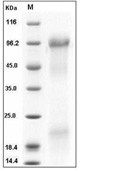Shopping Cart
- Remove All
 Your shopping cart is currently empty
Your shopping cart is currently empty

Osteopontin Protein, Human, Recombinant (His) is expressed in HEK293 mammalian cells with His tag. The predicted molecular weight is 35 kDa and the accession number is A0A024RDE2.

| Pack Size | Price | Availability | Quantity |
|---|---|---|---|
| 100 μg | $398 | In Stock | |
| 1 mg | $2,590 | 7-10 days |
| Biological Activity | Activity testing is in progress. It is theoretically active, but we cannot guarantee it. If you require protein activity, we recommend choosing the eukaryotic expression version first. |
| Description | Osteopontin Protein, Human, Recombinant (His) is expressed in HEK293 mammalian cells with His tag. The predicted molecular weight is 35 kDa and the accession number is A0A024RDE2. |
| Species | Human |
| Expression System | HEK293 Cells |
| Tag | C-His |
| Accession Number | P10451 |
| Synonyms | secreted phosphoprotein 1,OPN,ETA-1,BSPI,BNSP |
| Construction | A DNA sequence encoding the pro form of human SPP1 (NP_001035147.1) (Met 1-Asn 314) was fused with a polyhistidine tag at the C-terminus. Predicted N terminal: Ile 17 |
| Protein Purity | > 80 % as determined by SDS-PAGE  |
| Molecular Weight | 35 kDa (predicted); 60-65 kDa (reducing condition, due to glycosylation) |
| Endotoxin | < 1.0 EU/μg of the protein as determined by the LAL method. |
| Formulation | Lyophilized from a solution filtered through a 0.22 μm filter, containing PBS, pH 7.4. Typically, a mixture containing 5% to 8% trehalose, mannitol, and 0.01% Tween 80 is incorporated as a protective agent before lyophilization. |
| Reconstitution | A Certificate of Analysis (CoA) containing reconstitution instructions is included with the products. Please refer to the CoA for detailed information. |
| Stability & Storage | It is recommended to store recombinant proteins at -20°C to -80°C for future use. Lyophilized powders can be stably stored for over 12 months, while liquid products can be stored for 6-12 months at -80°C. For reconstituted protein solutions, the solution can be stored at -20°C to -80°C for at least 3 months. Please avoid multiple freeze-thaw cycles and store products in aliquots. |
| Shipping | In general, Lyophilized powders are shipping with blue ice. |
| Research Background | Osteopontin, also known as Secreted phosphoprotein 1, Bone sialoprotein 1, BSP-1, OPN, and SPP1, is a member of the osteopontin family and a SIBLING glycoprotein. Osteopontin has been classified as T-helper 1 cytokine and thus believed to exacerbate inflammation in several chronic inflammatory diseases, including atherosclerosis. Besides proinflammatory functions, physiologically Osteopontin is a potent inhibitor of mineralization, it prevents ectopic calcium deposits and is a potent inducible inhibitor of vascular calcification. Osteopontin is expressed and secreted by various cells, and has a role in cell adhesion, chemotaxis, prevention of apoptosis, invasion, migration and anchorage-independent growth of tumor cells. Osteopontin recruitment functions of inflammatory cells are thought to be mediated through its adhesive domains, especially the arginine-glycine-aspartate (RGD) sequence that interacts with several integrin heterodimers. Osteopontin has emerged as a potential biomarker and mediator in cardiovascular disease. In the context of atherosclerosis, OPN is generally regarded as a proinflammatory and proatherogenic molecule. However, the role of OPN in vascular calcification (VC), which is closely related to chronic and active inflammation, is that of a negative regulator because it is an inhibitor of calcification and an active inducer of decalcification. Extensive research has demonstrated the pivotal participation of Osteopontin in the regulation of cell signaling which controls neoplastic and malignant transformation. The elevated expression of Osteopontin has been observed in a variety of cancers. It has been linked with tumor metastasis and signifies a poor prognosis for the patient. |

Copyright © 2015-2025 TargetMol Chemicals Inc. All Rights Reserved.